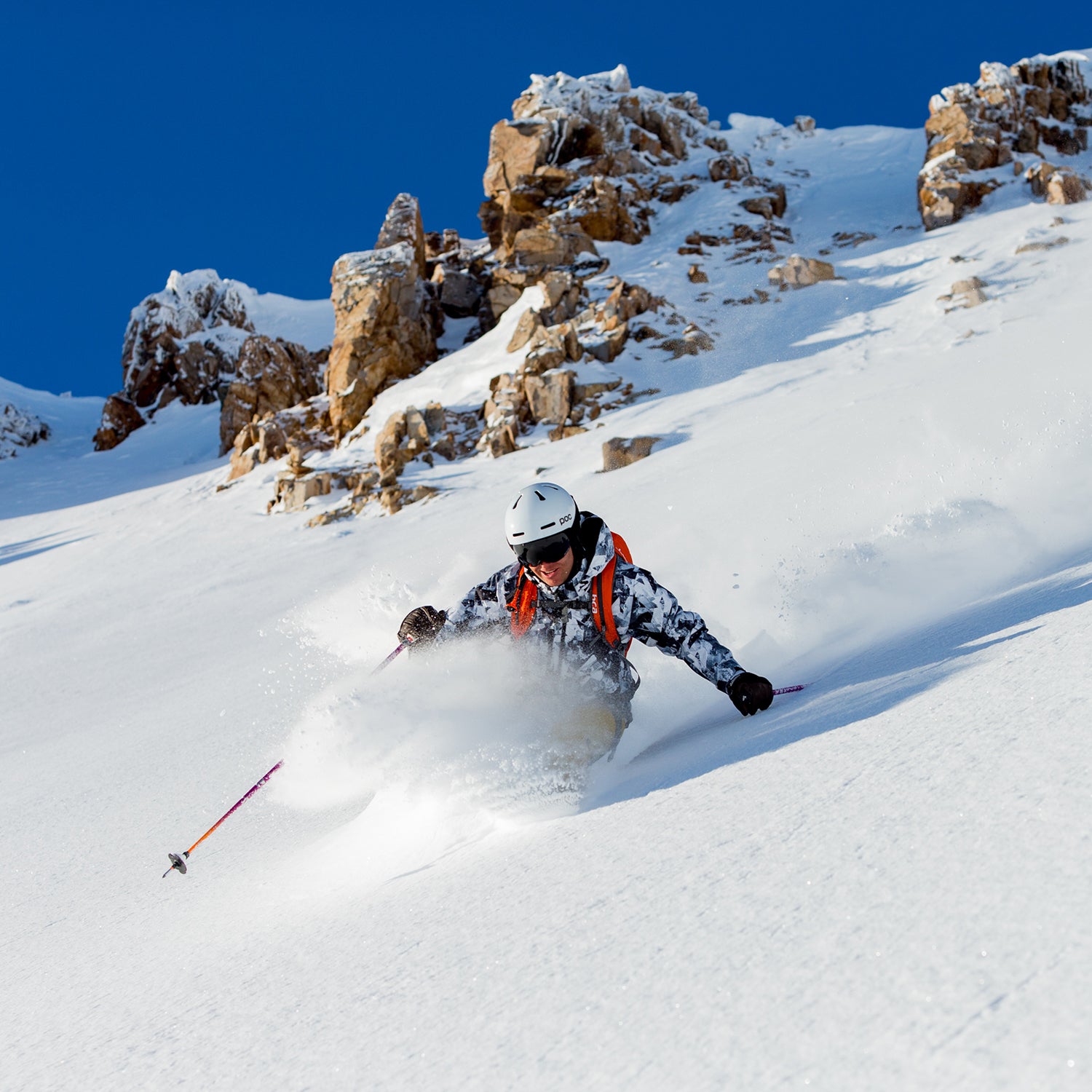Like any subculture with a passionate following, backcountry skiing has developed its own lingo—a special language that helps its practitioners describe what they do and why they love the sport. To anyone with an untrained ear, the words might sound like Greek. But with a little context, they start to make total sense. Here’s every term you need to know, from serious snow science to the proper usage of slang, so that there’s never a chance you sound like a gaper.
A:
airbag: A backpack with a large balloon that shoots out and inflates rapidly when activated by a user caught in an avalanche. Is proven to increase the odds of survival by keeping the skier closer to the surface of the avalanche debris flow.
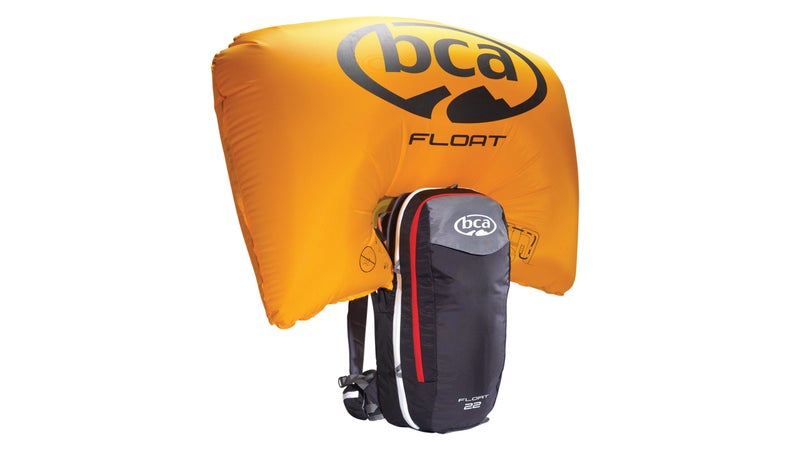
alpine touring (AT): A binding, boot, and ski system for both climbing and descending mountains.
après: What you do after skiing. Usually involves drinking and storytelling about your day. Often takes place on your tailgate in the parking lot while wearing comfy, post-ski gear like the Marmot Bridget and Anderson Flannels.
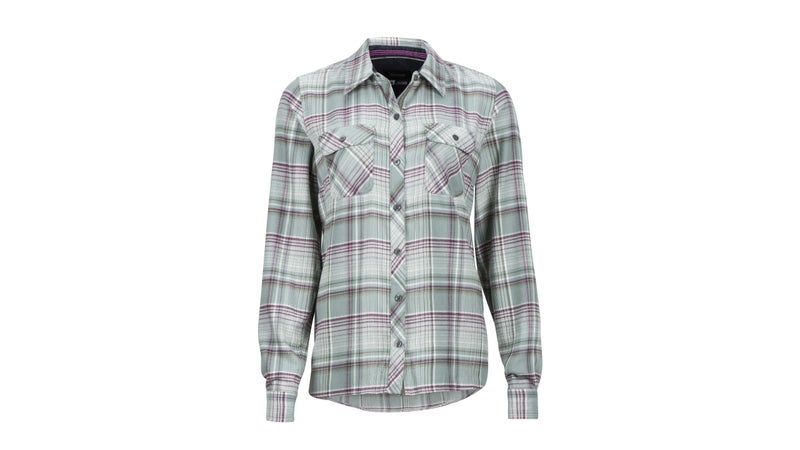
apron: Terrain descriptor. A wide-open section of a mountain’s face. Fun to ski.
aspect: The direction a slope faces, expressed in relation to compass points, i.e. “a southern aspect.”
avalanche beacon: An electronic device worn on the body that helps locate avalanche victims.
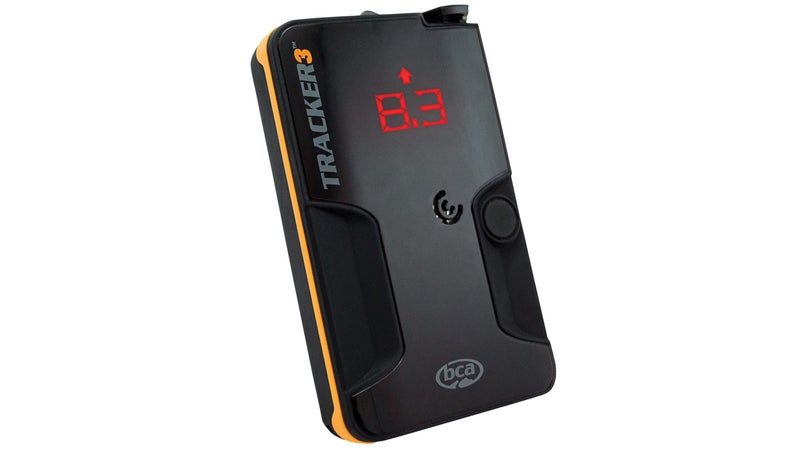
avalanche probe: A collapsible aluminum or carbon rod used to probe through avalanche debris and pinpoint buried victims.
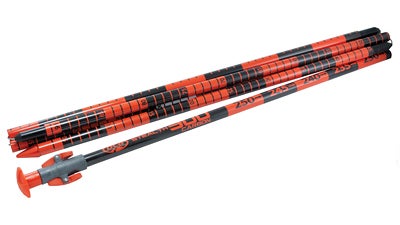
avy report: Short for avalanche report. A daily forecast prepared by snow scientists that describes the avalanche hazard and provides travel advice in a certain area of the local mountains. Avalanche.org maintains a list of avalanche centers around the country that issue avalanche forecasts.
B:
baselayer: A next-to-skin layer of clothing like the Marmot Harrier LS Crew that adds warmth and wicks moisture.
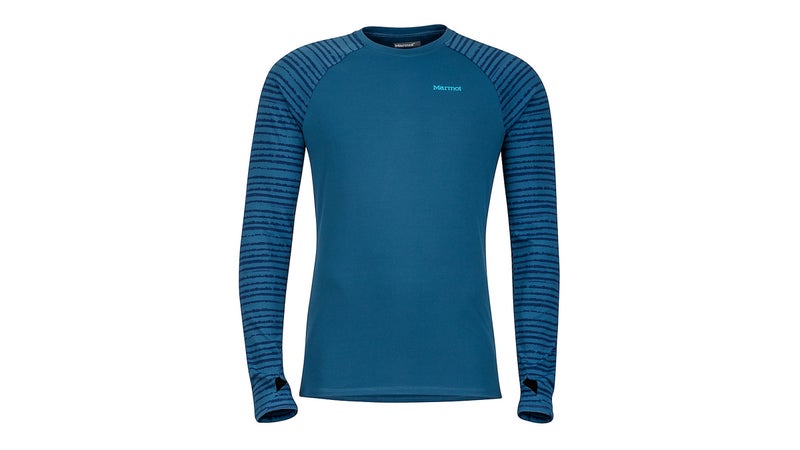
blower: Light, dry powder that “blows” into your face while skiing. The pursuit of blower has been known to cause ski bums to do irrational things, like quit a job, end a relationship, or break-dance fight a father of four for a better position in the tram line.
bluebird: A beautiful, sunny, cloudless day of skiing.
bomber: Adjective often used to describe the high strength of gear, a gear system, or the terrain in which a user is traveling. A bomber snowpack is stable and will not avalanche at that particular moment, and a bomber ski shell will not tear when raked against a tree branch. Case in point: the Marmot Alpinist Jacket.
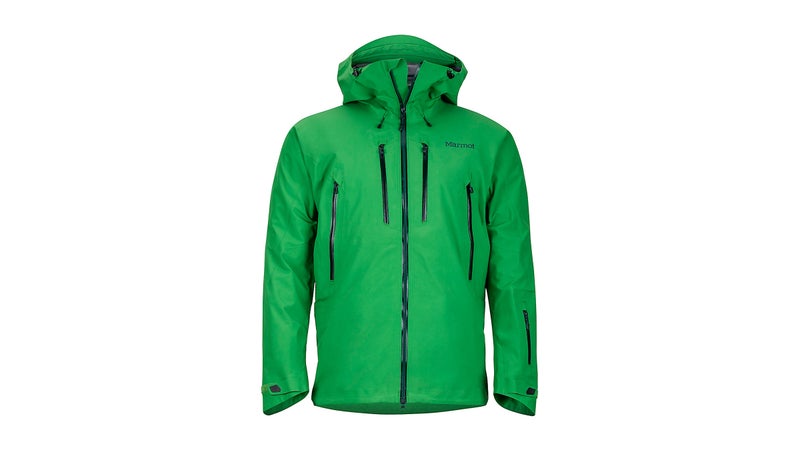
booter: A jump made of snow. Often natural but can also be man-made. Typically smaller than a kicker.
bootpack: A series of steps kicked into a steep section of a slope that acts as a staircase for gaining elevation. Often used when the terrain is too steep for skinning (see: skin track). A good way to sweat—and possibly vomit up your breakfast burrito.
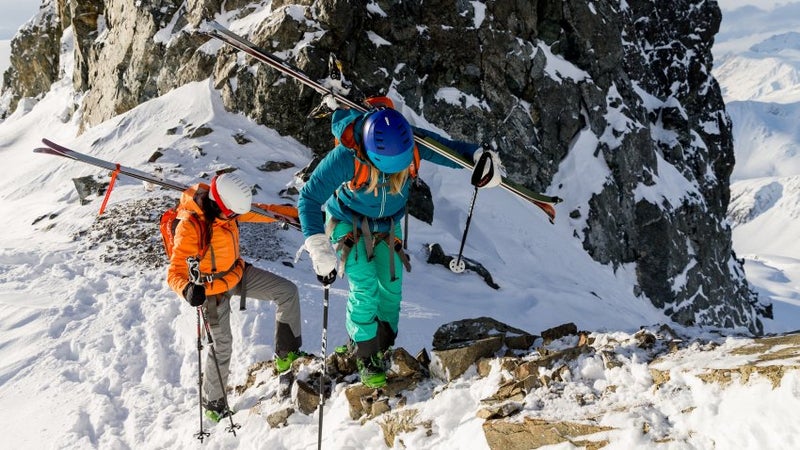
braap: Onomatopoeia used to describe the sound of a snowmobile engine. Often used by bros as a verb meaning “to use snowmobiles,” typically in a backcountry skiing scenario. “Let’s braap over into the next basin and see if it’s any safer.”
bucked: To get violently thrown off balance during a run, perhaps due to an object below the surface or landing a jump improperly.
C:
camber: Camber creates a slight upward arch in the middle of a ski or snowboard when it’s sitting flat on the ground. Helps with edging and springiness (see: rocker).
cement: Dense, high-water-content snow that’s usually produced by warmer storms. Associated with Lake Tahoe, as in “Sierra cement.” The opposite of Montana cold smoke.
chunder: Large chunks of snow and ice that clutter a ski run and make it no fun. Sometimes left behind by snowcats and during freeze-thaw cycles.
climbing skins: Long pieces of material that are cut to size then strapped to the bottom of AT skis, telemark skis, or split snowboards that allow for uphill travel on snow. Originally made of seal fur, most modern climbing skins use dense, angled synthetic fibers that allow a ski or board to glide forward but don’t allow it to slip backward.
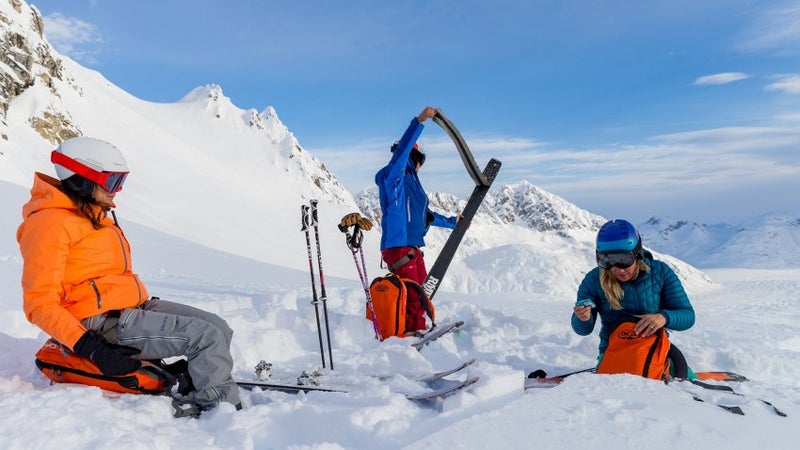
cold smoke: Just like blower but colder. Will cause a skier to whoop-n-holler like a wild animal. Often found in Montana.
cornice: A lip of snow that forms along the uppermost leeward edge of a cliff, often resembling the crest of a breaking wave. Cornices, having no support beneath them, can collapse along a fracture that extends back beyond the natural contours of the ridge. Cornice collapse can also trigger avalanches below.
corn snow: A layer of sun-softened snow atop a harder layer of frozen snow. Can form during any freeze-thaw cycle on sunny slopes, but typically associated with spring skiing in jeans. Some of the best corn snow is found at the Tordrillo Mountain Lodge in Alaska.
couloir: A narrow but skiable chute. Difficult to get to, hard to enter, and great to brag about.
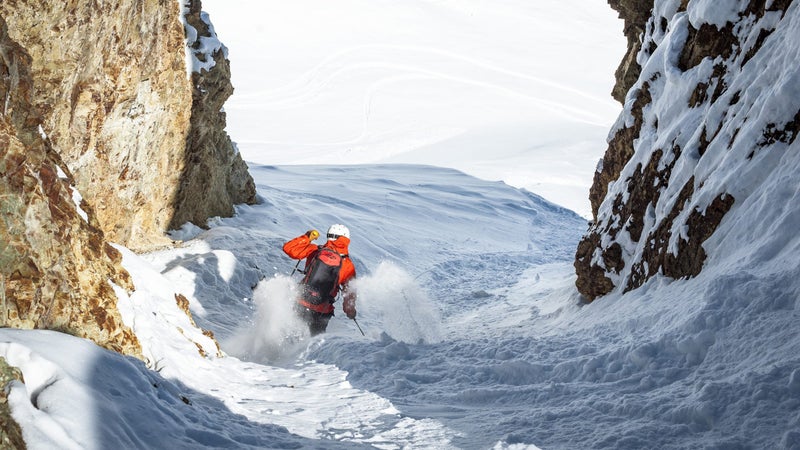
crown: The fracture line at the top of a slab avalanche. Crowns can be a few inches to more than ten feet thick. Pucker-inducing (see: gripped).
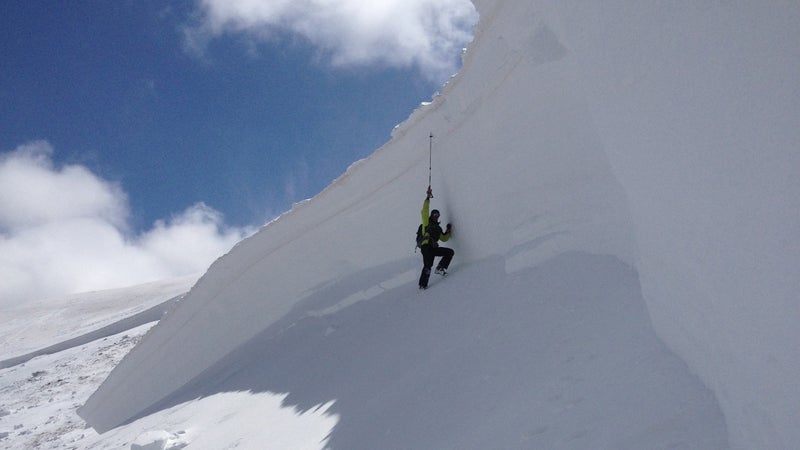
crud: Powder snow that has been cut and tracked by numerous other skiers. Also: that stuff stuck in the back of your teeth after eating a year-old granola bar you found in your ski jacket.
crust: A thin layer of frozen snow on top of softer or uncompact snow. Or, the poor attitude of a longtime local who talks about how great everything used to be thirty years ago.
crux: A particularly dangerous or difficult section of a ski slope. A place where you don’t want to fall (see: no-fall zone). For guide Miles Smart, it’s important to have safety gear when dealing with a crux. “When you get to a crux section where you are not able to make turns, it can be helpful to know how to use your ice ax while you’re still on your skis,” he says. “This extra security is sometimes all you need to get through.”
D:
dawn patrol: To be out backcountry skiing before the sun comes up. A way to squeeze in turns before work. What feels like a really dumb idea until the sun rises and the skiing begins.
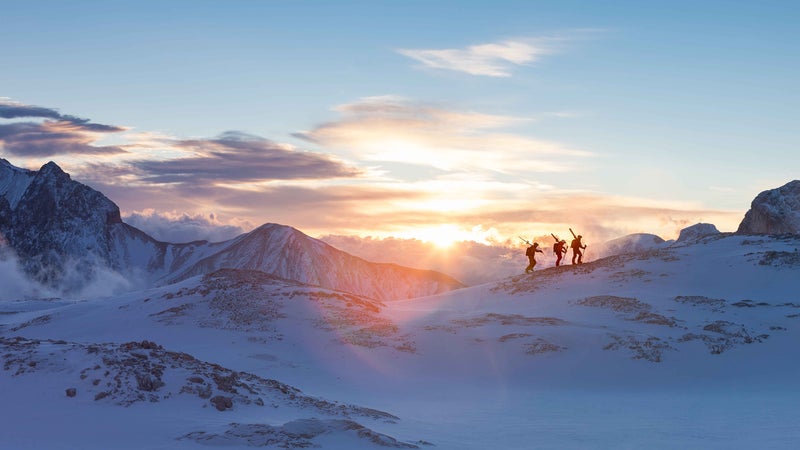
death cookie: A chunk of frozen snow (perhaps avalanche debris) that is no fun to ski over.
depth hoar: Large unstable snow crystals that form in snowpack below the surface and often trigger avalanches.
dumping: When it’s snowing a lot. Not quite as intense as nuking, but a heavy snowfall that might necessitate a “sick day.”
E:
elevation: Similar to altitude. The vertical difference in distance between a specific geographical point and sea level.
elevens: Tracks left by a skier who does not turn while heading downhill. Also called straight lining.
F:
face shot: A blast of snow to the face, usually caused by your skis or snowboard turning in deep powder. A frosty open-mouth kiss from Mother Nature. More sought after by ski bums than a significant other.
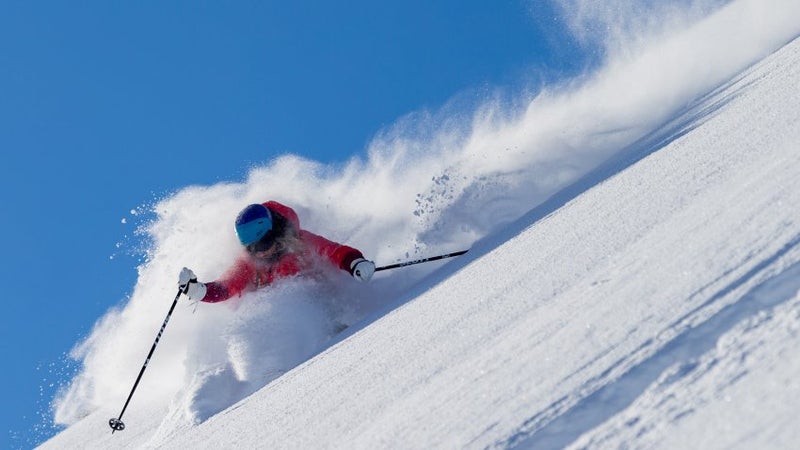
facets: Angular snow that does not bond well. Created from large temperature gradients within the snowpack. A major cause of avalanches.
featherless: A type of 3M™ Thinsulate™ insulation that feels like and matches up to down, but is made from synthetic materials so it also stays warm when wet. Found in premier midlayers and puffies like the Marmot Featherless Jacket.
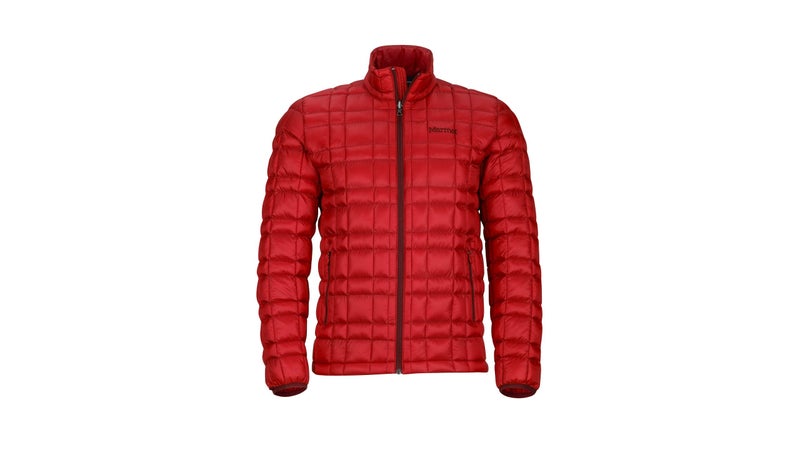
frankenskins: Climbing skins that have become heavy and unwieldy with no glide whatsoever due to large amounts of snow freezing and sticking to them.
freeheel skiing: Nickname for telemark skiing. Typically performed by a person with a steady weed habit or penchant for historical reenactments.
G:
gaper: A skier accused by others of being less cool. More generally: skiers who overestimates their ski skills or use their gear wrong. Something we’ve all been at one time or another.
gauntlet: The part of a ski glove that covers the wrist and extends up the forearm. A particularly bomber gauntlet comes on the Marmot Ultimate Ski Glove and helps seal out snow and add extra warmth.
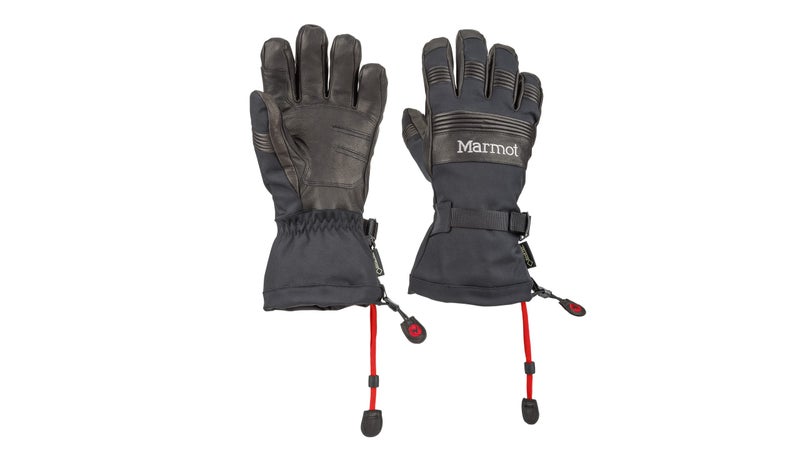
glop: Snow that thaws, refreezes, and attaches to a moving climbing ski in a heavy, unwieldy layer that drastically reduces efficiency (see: frankenskins).
Gore-Tex: A waterproof-breathable material that’s often found in high-end ski gear like the Marmot Dropway jacket. The best way to stay warm and dry while chasing face shots.
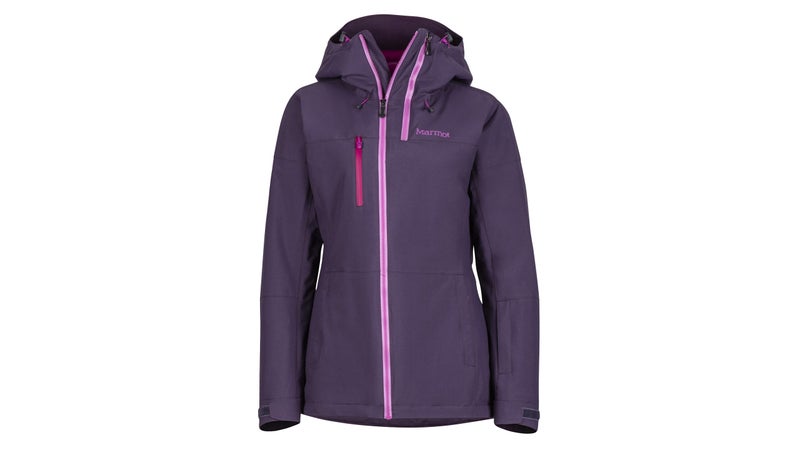
gripped: To be scared. Often experienced in places on a ski run where a fall would be highly unpleasant. Also referred to as “puckered,” which itself is a reference to a body part puckering when faced with fear.
H:
hero snow: Usually some kind of forgiving, easy-to-maneuver-in powder that allows a skier or snowboarder to perform at a higher level while also enjoying a lower risk of injury or catastrophic failure.
hot dog: To show off on skis. Tight, fast turns, daffies, spread-eagles, and backscratchers are all considered “hot dogging.” A staple of a ski bum’s diet. The greatest worst movie ever.
howitzer: An artillery piece, usually retired from military use, that fires explosive shells onto unstable mountain slopes to purposely trigger avalanches. Often used by ski areas and highway patrols to clear known slide paths. Makes really, really loud noises.
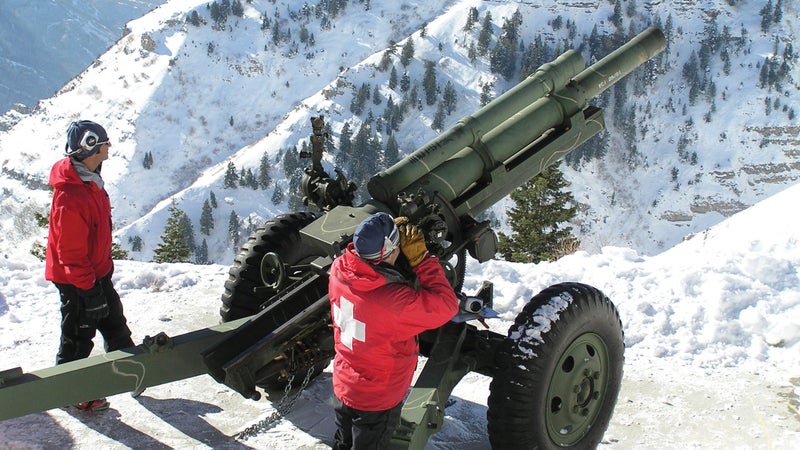
I:
ibuprofen: Necessity. Medicine used to control inflammation in sore, skied-out muscles. Also good for après hangovers.
ice ax: A standard piece of mountaineering equipment. A metal shaft with a spike at one end and an ax head at the other. Used to anchor a climber to a slope during steep climbs up couloirs. Also used to stop falls down a couloir. Ice climbers tackling vertical ice use highly specialized ice axes called “ice tools.” Also great for opening up cans of Hormel chili.
igloo: A dome structure made from blocks of snow. Used for snow camping. When filled with ski bums, unsurprisingly smelly inside.
J:
Jackson Hole: Fabled resort in northwest Wyoming. Birthplace of the Jackson Air Force. Bucket list.
Jerry: Similar to “Joey” or gaper. A person judged by others to be less fluent in the etiquette, culture, or general practice of a sport, particularly skiing. Examples: hitting a jump way too fast, landing wrong, and exploding into a yard sale on impact.
jump turn: A method whereby a skier or snowboarder jumps down a mountain, doing a 180 with every jump. Often used to stay in control in very steep, or “puckering” terrain.
K:
kicker: A ramp-like jump used for launching a skier or snowboarder into the air so that something sick might occur.
kick turn: A technique used for navigating a switchback when traveling uphill on skis. Surprisingly difficult. Has caused many experts to fall over. Also hard to explain. Watch this video instead.
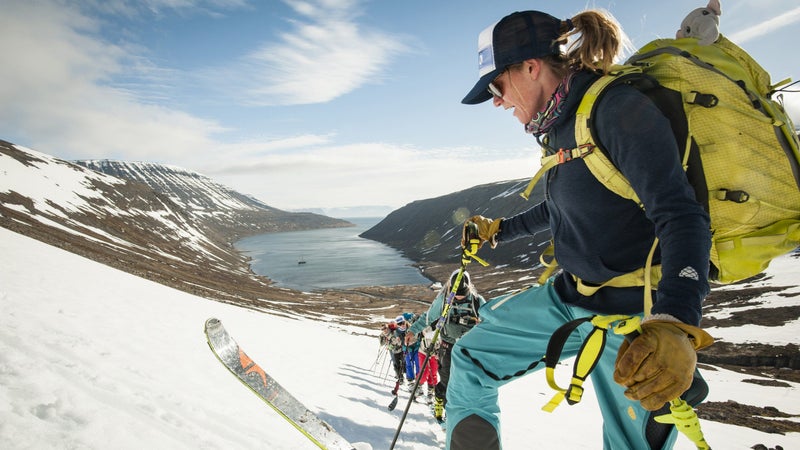
krummholz: Any type of high-alpine tree or vegetation deformed by the high winds and severe weather encountered at such elevations. Flagging, whereby branches only grow on the leeward side of a tree trunk, is an example of a krummholz deformity.
L:
laps: Number of descents a skier or snowboarder logs on a particular slope. Lap: to ski or snowboard a slope numerous times.
line: The chosen path a skier or snowboarder takes down a slope, mountain, or particular section of either.
Lock Down: Verb: to change AT bindings from the pivoting walk mode to locked-down ski mode where the heel is locked in place. Also a reference to ski-town dating, as in, “I need to lock down a girlfriend.”
M:
mandatory air: A cliff band or other un-skiable feature on a slope or in a couloir that requires a jump (or sometimes a rappel with ropes) to overcome.
man soup: Also man tea or brocuzzie. A hot tub full of dudes.
mashed potatoes: Dense, heavy snow typically associated with warming temperatures. Be prepared for saturated ski pants.
N:
no-fall zone: An area in the mountains where a skier cannot afford to fall, thanks to some kind of terrain below that will lead to injury or death. Sometimes fun to ski. Sometimes the cause of an existential crisis, such as “Why am I here?”
noodling: A form of hot-dogging in which long, skinny skis are placed as tightly together as possible when making turns. Often referred to as hippie wiggles.
north facing: A reference to the direction a ski slope faces. Desirable, often times, because north-facing slopes do not get as much direct sunlight and therefore the snow stays powdery for longer amounts of time.
nuking: To snow heavily at a rate that is greater than dumping and far greater than “it’s snowing.” Will cause grown men to squeal.
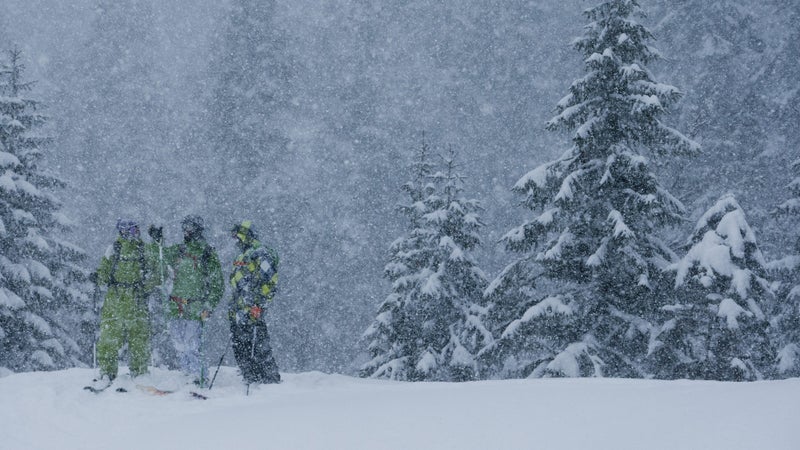
O:
objective: Your goal for the day. Usually used in reference to a mountaintop or ski slope you want to reach. “It’s always great to have an objective, but be careful of being too objective-oriented,” says pro skier Jess McMillan. “Set a turn-around time, always be aware of changing conditions, and if anyone in your group feels spooked, be OK with turning around. Live to ski another day!”
off-camber: A downward slope that’s also curved to one side so that the fall line isn’t oriented right down the middle. The way an overserved ski bum leans at the end of a long night.
out-of-bounds: Sections of a mountain that sit beyond the ski area boundary. Also referred to as the backcountry.
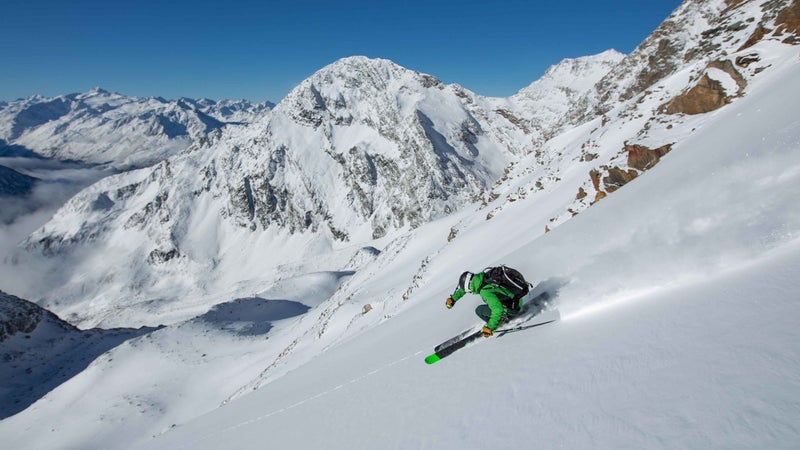
off-piste: French for out-of-bounds.
P:
pillow line: A downward slope dotted by boulders that look like fluffy pillows when covered with snow. Skiers and snowboarders usually descend by jumping from “pillow to pillow” without hitting actual rock.
pinwheel: A clump of snow that falls down a slope gathering more snow mass as it rolls.
pitted: To make a turn in deep powder. Often results in a face shot. A skier’s friend. An olive’s nightmare.
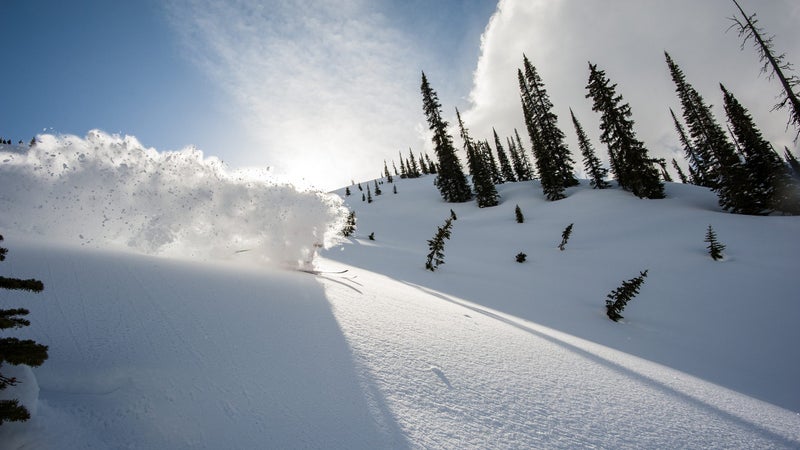
postholing: When your foot and leg fall through a crusty top layer of snow into softer, rotten snow below, creating what looks like a hole big enough for a post. A great way to overexert yourself and a proper place to start dropping f-bombs.
powder skirt: An elastic piece of material that wraps around the inside of a ski jacket like Marmot’s La Meije and prevents snow from creeping inside when you call.
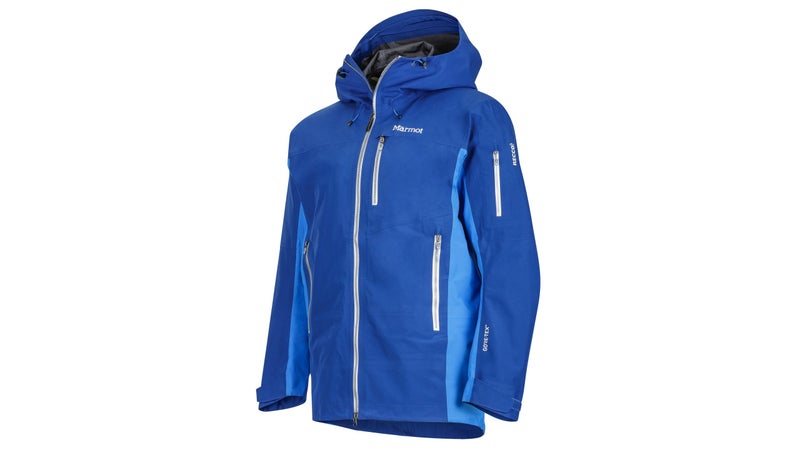
puffy: Short for an insulated outer layer like the Marmot Quasar Nova Hoody.
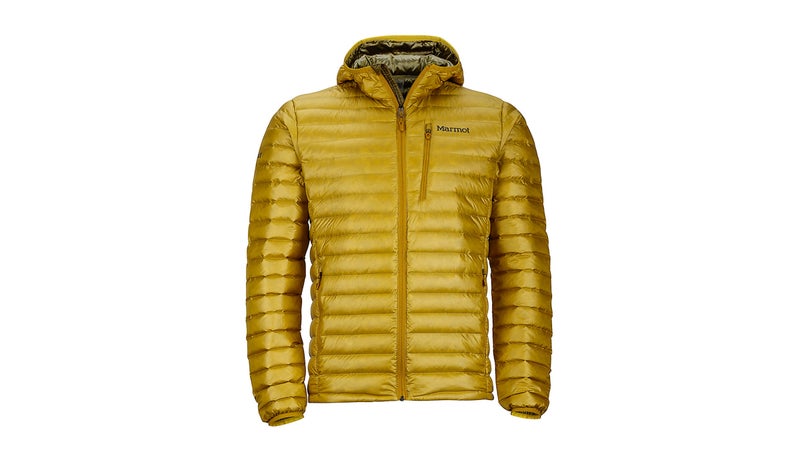
Q:
quads: Short for quadriceps. The large thigh muscles that can ignite into burning masses on steep runs or grueling uphills. The integral part of one’s lap or leg seat for a main squeeze.
quinzee: A type of snow shelter. Formed by shoveling snow into a large pile and then hollowing out a living space inside. A ski-bum igloo.
quiver: Your collection of skis. Use: “I have a powder ski, a touring ski, and a rock ski in my quiver.”
R:
rag doll: To fall violently head-over-heels down a slope in such a manner that the movement of one’s limbs appears to be out of one’s control completely, as if they were lifeless and attached to a doll. Not fun.
randonee: French for any trip through the mountains on foot. Here in the United States we equate randonee with alpine touring.
RECCO: An avalanche safety system. Small RECCO reflectors are embedded into ski clothing and those reflectors can be detected by a handheld transmitter-receiver in the event of an avalanche. Found in some ski pants, like Marmot Refuge.
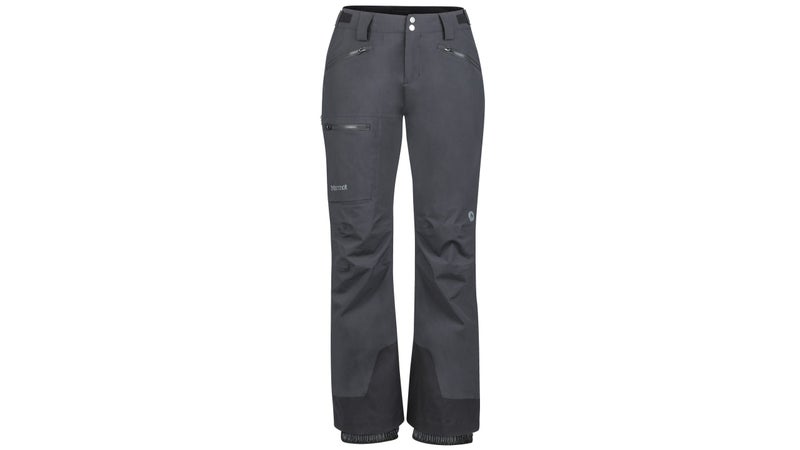
rocker: The opposite of camber. A rockered ski has an upward arch when laid flat on the ground. This helps the ski maneuver through powder. Also a way to reference any particularly upturned part of a ski. Rocker and camber can be used together, as in, “The ski has a rockered tip but camber underfoot.” A good way to get face shots.
S:
safe zone: An area where a skier will not trigger or be exposed to an avalanche. Backcountry skiers should always regroup in safe zones when waiting for each other.
schralp: To ski aggressively and fluidly through challenging terrain, often at great speed.
shmoo: A generally unpleasant form of snow similar to mashed potatoes that results from tracked out powder going through numerous freeze-thaw cycles to become something like a less slushy slush.
shovel: Backcountry shovels come with a removable head and telescoping handle, so they fit in your backcountry pack. Used to dig out avalanche victims.
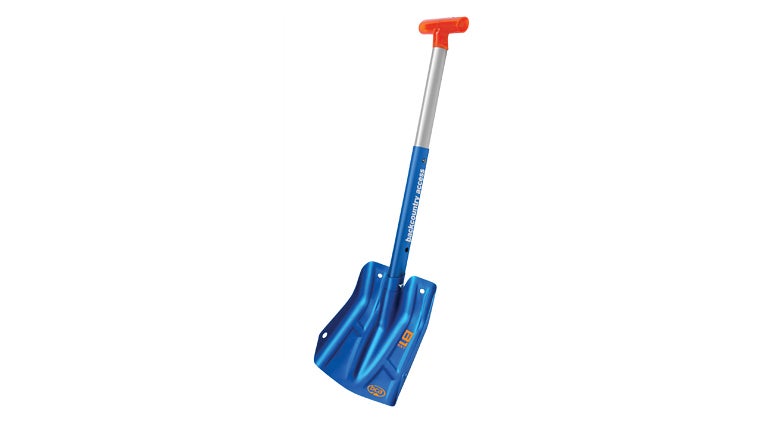
skin track: The route you use to skin up a slope. An important part of backcountry navigation. “One of the most crucial ingredients for a good day of ski touring is setting a good track,” says guide Zach Crist. “Often people tend to choose a straighter line to the top, but that approach becomes highly inefficient when the slope angle increases. A proper track—no steeper than 20 degrees—helps maintain a steady pace, which helps keep your body temperature stable and reduces the need to frequently adjust your gear.”
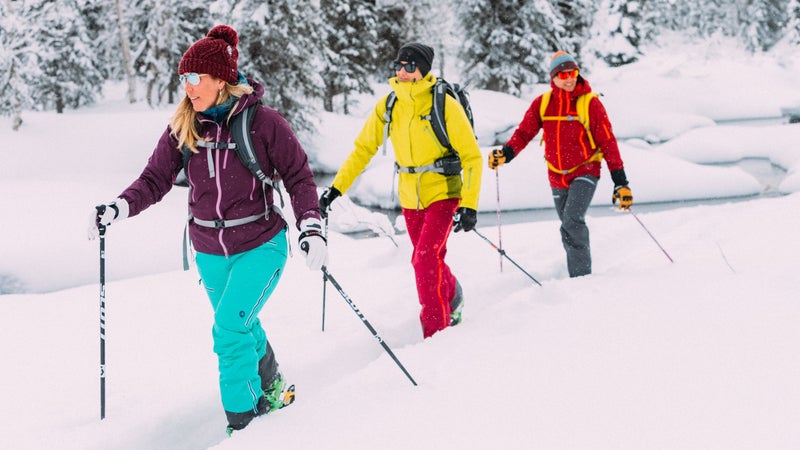
slackcountry: Backcountry terrain that sits right outside a ski area’s boundary. Often reached by riding the ski area’s chairlift. The term is going out of fashion. Now more commonly referred to as lift-served backcountry.
sluff: Falling snow that’s knocked loose by a skier, usually on a steep pitch. Not the same thing as an avalanche, but capable of sweeping a skier off his or her feet.
snowpack: The layers of snow accumulated over a season. Avalanche forecasters study the layers in snowpack to determine the likelihood of an avalanche.
soft shell: A highly-breathable outer layer like the Marmot ROM (in both men’s and women’s jackets) that cuts the wind and adds warmth but it not totally waterproof. Perfect for backcountry skiing on bluebird days.
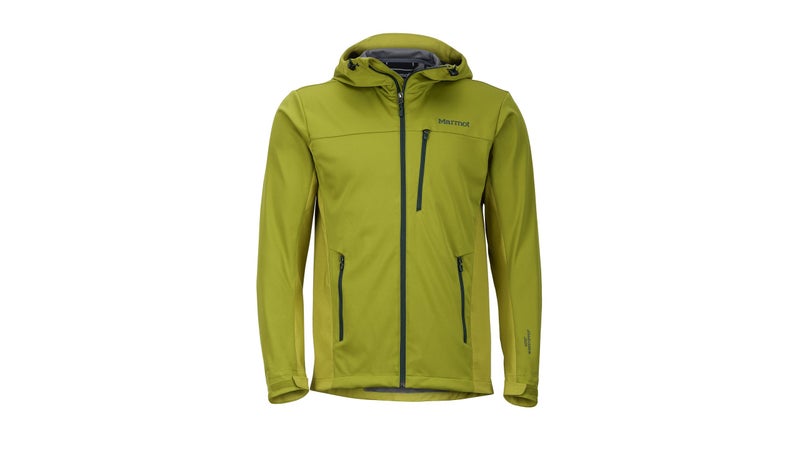
splitboard: A type of snowboard that separates down the middle along the tip-to-tail axis to become two “skis” for easier uphill mobility when combined with climbing skins. The user can then put the two skis back together to form a single snowboard for descents.
steezy: Adjective describing a fluid, relaxed style that exudes confidence. Can also be applied to a piece of gear.
switchbacks: The turn section of the zig-zag paths that skiers use to skin up steep fields of snow (see: kick turn).
T:
tech bindings: A type of lightweight, two-piece AT binding. Different from a frame backcountry binding.
telemark: A form of skiing where the toe of your boot is always free to pivot because the heel is never attached to the ski. Turns are initiated by sliding the uphill ski forward and the downhill ski backward to put the user into a “drop knee” position.
terrain trap: An area where snow from an avalanche can collect and bury a victim. Like a river bed below a couloir. Backcountry travelers need to be aware of terrain traps at all times.
tomahawk: To fall violently head over tails down a slope in a motion similar to the rotation of a thrown ax. Like Glen Plake in Blizzard of Aahhh’s.
tree well: A dangerous area of deep, unconsolidated snow that forms under a tree and around its trunk. Skiers and snowboarders die every year from falling into tree wells and suffocating.
U:
Ullr: Norse god proficient on skis and with a bow. The patron saint of skiers. Revelers in Breckenridge, Colorado, celebrate Ullr during their annual Ullr Fest. The giver of the goods, the keeper of the gnar, the lord of winter. Mother Nature’s side dude.
uphill travel: Otherwise known as uphill skiing. Performed with specialized ski gear that allows a skier to ascend a slope covered in snow (see: climbing skins, tech bindings, telemark).
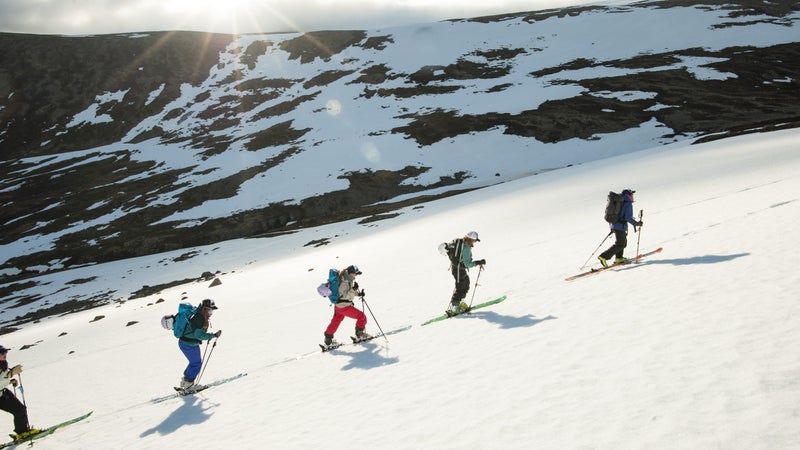
V:
variable: A reference to variable snow conditions on a particular slope. A term used by someone who considers him or herself an expert skier but has just fallen.
vert: Short for vertical, or the amount of elevation change between the top of a run and its end point.
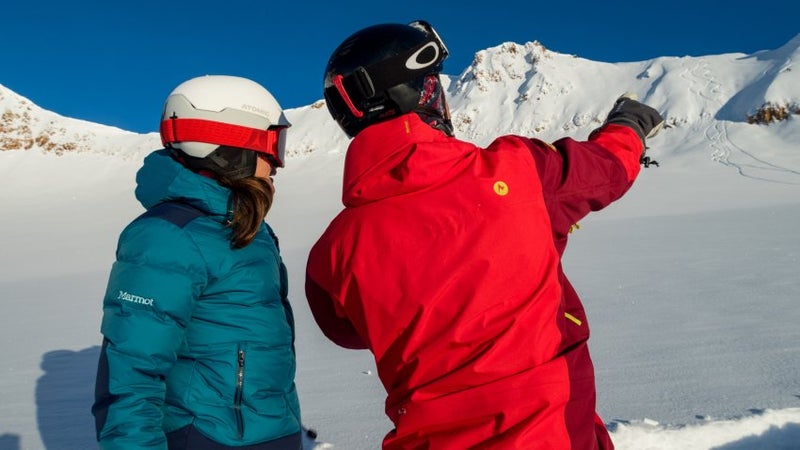
W:
walk mode: A setting on alpine touring or telemark boots that increases their forward and backward flex, so they can have a more natural stride when skiing uphill. Walk mode is changed to ski mode at the top, which stiffens the boot for the descent. Great for extended après-ing. Nobody’s dancing all night in alpine boots.
white room: A descent through deep powder in which face shots become so frequent that a skier can grow disoriented, as if standing in an all white room with no defining edges.
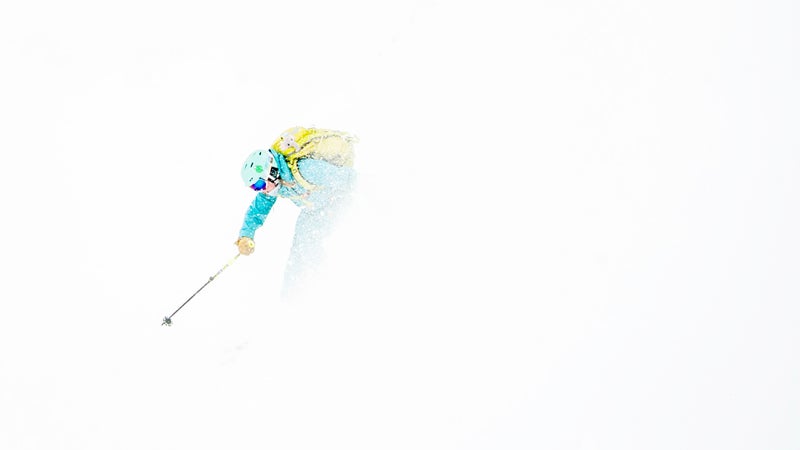
whumpf: A sound caused by weak layers in the snowpack collapsing, often under the weight of a backcountry skier. Indicative of instability and sometimes a sign that an avalanche just started. Not a good sound to hear in the backcountry. May cause you to wet yourself.
wind slab: A layer of hardened snow built up by wind currents depositing snow in a particular area of a slope. Wind slabs are a common cause of avalanches.
X:
XC: Short for cross country. Abbreviation used by those who enjoy spandex-clad ski walking.
X-ray: What you end up getting if you act like a Jerry in the backcountry. Bone selfies!
Y:
yahoo: A reckless person whose actions are likely to result in injury, either to the yahoo or others. Yahoos who drive way too fast down snowy roads, venture poorly prepared into the backcountry, and take blind jumps.
yard sale: To crash so violently that most of your gear—skis, poles, hat, goggles, etc.—is strewn across the slope as if part of a yard sale. Can be funny to see from the chair lift. Is not fun to participate in.
yeti: A hairy creature with enormous feet that roams the Himalayas and who may or may not own a very rugged cooler. Or, that hairy dude in the hot tub who talks too much and makes very awkward eye contact.
yurt: Russian word for the round, skin- or canvas-wrapped shelters favored by the nomadic peoples of Siberia and Asia. Similar to the Mongolian ger. Now used frequently used in the American backcountry as huts where skiers can spend the night on longer trips. A ski bum dwelling that will always smell like wet wool and old festival sandals.
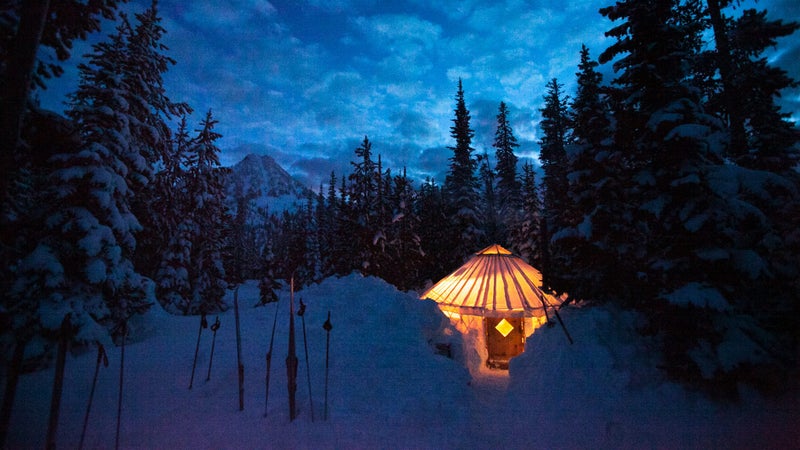
Z:
zipper crust: A thin, frozen layer on top of softer snow that is too weak to support any weight, but thick enough to be felt. Skiing through it can often produce a sound similar to a zipper opening or closing.
For more on the backcountry apparel you need to have fun outside, please visit marmot.com.

